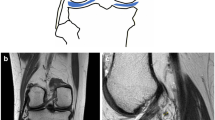Abstract
Purpose
The displacement and deformation of the knee meniscus significantly affect its roles; however, little is known about the displacement and deformation patterns of a torn medial meniscus. The objective of this study was to evaluate quantitatively the patterns of displacement and deformation in horizontally torn medial menisci during knee flexion.
Methods
Twenty patients with horizontally torn medial menisci underwent three-dimensional (3-D) magnetic resonance imaging at varying degrees of knee flexion, and 3-D computer models of the tibia, tibial articular cartilage, and meniscus were generated. Based on these, the size of the horizontal tear (% tear) was evaluated and defined as the circumferential ratio between the length of the horizontal tear and that of the entire meniscus. The 3-D meniscus models were automatically superimposed over images taken at 0, 20, 40, and 60° of knee flexion by the voxel-based registration method. Meniscal motion and deformation during knee flexion were visualized and quantitatively calculated on the mid-sagittal plane. Correlations between the size of horizontal tear, displacement/deformation of torn menisci, and clinical symptoms were evaluated after conservative treatment for 3 months.
Results
The % tear was 35.7 ± 12.5 % (range 13.7–55.5 %). During knee flexion, all torn menisci moved posteriorly, with gradual widening of horizontal and vertical gaps (p < 0.05). A direct correlation was observed between % tear and change in the vertical tear gap during knee flexion (p < 0.05). There was an inverse correlation between Lysholm score and % tear (p < 0.05).
Conclusion
Medial meniscal horizontal tears widen and deform during knee flexion, and % tear correlates with the change in the vertical gap. Patients with a lower % tear are more capable of performing activities of daily living after conservative treatment. This method may help clarify the cause of pain in patients with medial meniscus tears as well as facilitate the selection of an appropriate treatment plan.
Level of evidence
Case series, Level IV.






Similar content being viewed by others
References
Bao HR, Zhu D, Gong H, Gu GS (2013) The effect of complete radial lateral meniscus posterior root tear on the knee contact mechanics: a finite element analysis. J Orthop Sci 18:256–263
Bessette GC (1992) The meniscus. Orthopedics 15:35–42
Boxheimer L, Lutz AM, Treiber K et al (2004) MR imaging of the knee: position related changes of the menisci in asymptomatic volunteers. Invest Radiol 39:254–263
Boxheimer L, Lutz AM, Weishaupt D et al (2006) Characteristic of displaceable and nondisplaceable meniscal tears at kinematic MR imaging of the knee. Radiology 238:221–231
Brown LG (1992) A survey of image registration techniques. ACM Comput Surveys 24:325–376
Duc SR, Pfirrmann CW, Hodler J et al (2007) Articular cartilage defects detected with 3D water-excitation true FISP: prospective comparison with sequences commonly used for knee imaging. Radiology 245:216–223
Goto A, Moritomo H, Ochi T et al (2005) In vivo three-dimensional wrist motion analysis using magnetic resonance imaging and volume-based registration. J Orthop Res 23:750–756
Hauger O, Frank LR, Resnick D et al (2000) Characterization of the “Red zone” of knee meniscus: MR imaging and histologic correlation. Radiology 217:193–200
Hsieh HH, Walker PS (1976) Stabilizing mechanisms of the loaded and unloaded knee joint. J Bone Jt Surg 58A:87–93
Jang KM, Ahn JH, Wang JH (2012) Arthroscopic partial meniscectomy of a posteriorly flipped superior leaflet in a horizontal medial meniscus tear using a posterior transseptal portal. Orthopedics 35:430–433
Kawahara Y, Uetani M, Hayashi K et al (1999) MR assessment of movement and morphologic change in the menisci during knee flexion. Acta Radiol 40:610–614
Kim YM, Joo YB (2013) Pullout failure strength of the posterior horn of the medial meniscus with root ligament tear. Knee Surg Sports Traumatol Arthrosc 21:1546–1552
Lorensen W, Cline H (1987) Marching cubes: a high resolution 3D surface construction algorithm. Comput Graphics 21:163–169
Markolf KL, Mensch JS, Amstutz HC (1976) Stiffness and laxity of the knee. The contributions of the supporting structures: a quantitative in vitro study. J Bone Jt Surg 58A:583–594
McBride ID, Reid JG (1988) Biomechanical considerations of the menisci of the knee. Can J Sport Sci 13:175–187
Moritomo H, Goto A, Yoshikawa H et al (2003) The triquetrum-hamate joint: an anatomic and in vivo three-dimensional kinematic study. J Hand Surg 28A:797–805
Scholes C, Houghton ER, Lee M, Lustig S (2013) Meniscal translation during knee flexion: what do we really know? Knee Surg Sports Traumatol Arthrosc. doi:10.1007/s00167-013-2482-3
Seedhom BB (1979) Transmission of the load in the knee joint with special reference to the role of the menisci. Part 1: anatomy, analysis and apparatus. Eng Med 8:207–228
Shefelbine SJ, Ma CB, Majumdar S et al (2006) MRI analysis of in vivo meniscal and tibiofemoral kinematics in ACL-deficient and normal knees. J Orthop Res 24:1208–1217
Stoller DW, Martin C, Mink JH et al (1987) Meniscal tears: pathologic correlation with MR imaging. Radiology 163:731–735
Thompson WO, Thaete FL, Fu FH, Dye SF (1991) Tibial meniscal dynamics using three-dimensional reconstruction of magnetic resonance images. Am J Spots Med 19:210–215
Vasanawala SS, Hargreaves BA, Gold GE et al (2005) Rapid musculoskeltal MRI with phase-sensitive free precession: comparison with routine knee MRI. Am J Roentgenol 184:1450–1455
Vedi V, Williams A, Gedroyc WM et al (1999) Meniscal movement. An in vivo study using dynamic MRI. J Bone Jt Surg 81B:37–41
Yamada Y, Toritsuka Y, Shino K et al (2007) Morphological analysis of the femoral trochlea in patients with recurrent dislocation of the patella using three-dimensional computer models. J Bone Jt Surg 89B:746–751
Yao J, Lancianese SL, Hovinga KR, Lee J, Lerner AL (2008) Magnetic resonance image analysis of meniscal translation and tibio-menisco-femoral contact in deep knee flexion. J Orthop Res 26:673–684
Author information
Authors and Affiliations
Corresponding author
Rights and permissions
About this article
Cite this article
Amano, H., Iwahashi, T., Suzuki, T. et al. Analysis of displacement and deformation of the medial meniscus with a horizontal tear using a three-dimensional computer model. Knee Surg Sports Traumatol Arthrosc 23, 1153–1160 (2015). https://doi.org/10.1007/s00167-014-2931-7
Received:
Accepted:
Published:
Issue Date:
DOI: https://doi.org/10.1007/s00167-014-2931-7




